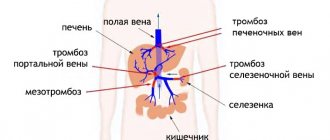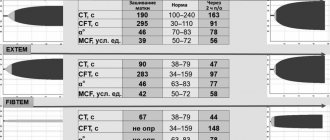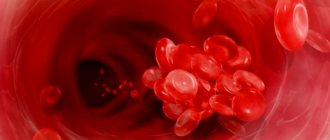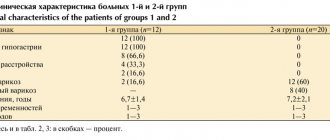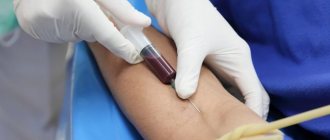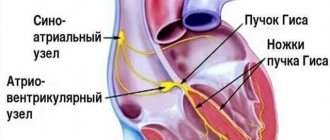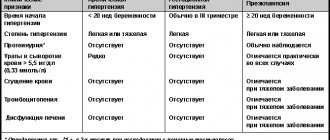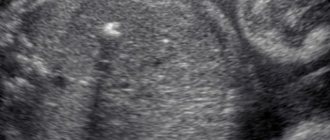Causes
Iron, which comes from food, is absorbed in the gastrointestinal tract and settles in certain human organ systems, be it the liver or joints.
The reason for this process may be either the action of a gene that provokes increased absorption of iron, or long-term excessive intake of this element into the body along with chemicals or blood transfusions. Degradation of organs affected by excess iron does not occur immediately, but over time the symptoms only progress.
What is hemochromatosis?
Hemochromatosis
is a hereditary disease in which iron metabolism in the body is disrupted. As a result, the trace element accumulates in excess in the pancreas, liver, spleen, myocardium, endocrine glands and skin. Because of this, carbohydrates, proteins and even DNA molecules of organs are destroyed.
Thus, iron accumulated in the liver threatens the patient with cirrhosis, liver failure, and liver cancer. If there is an excess of the microelement in the pancreas, diabetes will develop, and if there is too much iron in the heart, heart failure will develop. In addition, iron can be deposited in the pituitary gland. Failure of this organ disables the entire endocrine system. As a result, men become “more feminine” (breasts grow, testicles atrophy, etc.), and women become “more masculine” (hair growth increases, the menstrual cycle is disrupted, infertility may occur).
Prevention
Knowing that hemochromatia can occur due to prolonged blood transfusion, when carrying out this procedure, you should adhere to a diet that will reduce the entry of iron into the body. Reducing the amount of alcohol you drink also reduces the risk of excess iron in your body. If there is a risk of hemochromatia associated with heredity or certain circumstances, you should undergo preventive diagnostics by an endocrinologist approximately once every three months.
COVID-19 and iron metabolism
During infectious diseases, in addition to classical markers of inflammation such as accelerated ESR, increased C-reactive protein, changes in iron metabolism also occur.
The total iron content in the adult human body is approximately 4 g, with two-thirds of this amount included in hemoglobin. Iron stores (mainly in the spleen, liver, bone marrow and macrophages) account for about 1/4 of the total amount of iron in the body. Of the remaining amount, most is contained in myoglobin and other hemoproteins; only 0.1% of the body's total iron is found in the blood serum, where it is bound to the transport protein transferrin.
During infection, iron levels in the blood decrease.
This occurs due to the absorption and deposition of it by activated histiocytes - macrophages, iron accumulates in macrophages in the form of ferritin, the transfer of which from ferritin to transferrin is disrupted, as a result, the concentration of ferritin in the blood increases 3 times or more, which is what we observe in patients with COVID -19.
Additional tests confirming that iron deficiency is associated with inflammation are latent and total serum iron binding capacity (SIBC and TIC). Typically only 25-30% of transferrin is saturated with iron, the additional amount of iron that may be bound represents the latent iron binding capacity of the serum, which is reduced by inflammation.
Accordingly, the total iron binding capacity of the serum is also reduced, since this indicator is the sum of serum iron and LVSS and reflects the total amount of iron that the blood can transport. LVSS and VTSS are more stable indicators, unlike blood iron, the level of which can vary from day to day and depending on the time of day.
So, with inflammation, incl. caused by the pathogen COVID-19, in the blood there is a decrease in the concentration of serum iron, a decrease in the level of transferrin, LVSS, TGSS and a significant increase in ferritin. Doctors often call hyperferritinemia a marker of severe coronavirus infection.
It must be remembered that the values of laboratory parameters depend on the time since the onset of symptoms, as well as on the presence of concomitant diseases. The clinical picture and symptoms may vary greatly between patients.
All these studies are performed in a medical laboratory. Execution time - 1 day, in CITO mode - 2 hours.
Symptoms of hemochromatosis:
- The most recognizable symptom of hemochromatosis is a specific gray-brown or bronze skin tone (the disease is also called “bronze diabetes”). The patient’s face, neck, arms and legs, and genitals are “painted” in such shades. At the same time, the folds of the skin and palms remain light.
- weakness, apathy, fatigue, decreased libido
- weight loss
- hair loss on the face and body
- pain in the joints and right hypochondrium.
Heavy menstruation is a cause of anemia
Heavy menstruation is menstrual blood loss that causes disruption to a woman's physical or emotional health. According to the International Society of Obstetricians and Gynecologists (FIGO), the incidence is 3-30% among women of reproductive age.
Causes of heavy menstruation
Heavy menstruation can be considered a special case of abnormal uterine bleeding.
The reasons are combined into the acronym PALM-COEIN. Among them: 1. Polyp
– benign formation of the endometrium (inner layer of the uterus).
2. Adenomyosis
– a special case of endometriosis, in which endometrial foci are located in the myometrium (muscular layer of the uterus).
3. Leiomyoma
– benign tumor of the uterus. The volume of menstruation is largely influenced by the submucosal nodes.
4. Malignancy and hyperplasia
– atypical changes in the endometrium and uterine cancer.
5. Coagulopathy
– disorders in the blood coagulation system.
6. Ovulatory dysfunction
– changes in the hormonal function of the ovaries.
7. Functional disorders in the endometrium
.
8. Iatrogenic factors, when the cause is medical interventions.
9. Unclassified violations
.
Normal menstrual blood loss
Normally, menstruation has the following parameters (according to FIGO criteria, 2021):
- The duration of menstruation is 3-8 days;
- The duration of the menstrual cycle is 24-38 days;
- The volume of blood loss is 5-80 ml;
- Regularity is defined as a regular change from the shortest to the longest cycle within 7-9 days.
Each menstrual cycle for a woman can vary both in duration and in the nature of the menstruation itself. Not every deviation from the traditional 28 days is considered pathological.
To clarify the diagnosis of heavy menstruation, the Russian gynecological school uses the following terms:
- menorrhagia – long (more than 8 days) and heavy (more than 80 ml) menstruation;
- polymenorrhea – frequent regular menstruation (cycle less than 24 days);
- hypermenorrhea – regular and abundant (more than 80 ml);
- menometrorrhagia – long-term (more than 8 days) and heavy (more than 80 ml) in combination with intermenstrual discharge.
A woman can independently determine the amount of menstrual blood loss, focusing on the Mansfield-Vode-Jorgensen scale. According to her, you need to seek help in the following situations:
- heavy bleeding, when a highly absorbent tampon or pad needs to be changed every 3-4 hours;
- intense (severe) bleeding, when hygiene products are changed more often than every 2 hours.
Blood analysis
Heavy menstrual bleeding is dangerous for the development of anemia. It is indicated by the following indicators in blood tests (general and biochemical):
1. Decrease in hemoglobin below 120 g/l or 12 g/dl. Normal values may persist during latent anemia, so other blood parameters are also analyzed.
2. Red blood cell size (MCV) less than 80 fl.
3. The hemoglobin content in the erythrocyte (MCH) is less than 22 pg.
4. Serum iron less than 12 µmol/l.
5. Ferritin. The norm depends on the determination method; the values are indicated in the analysis form. To reliably exclude latent anemia, it should not be lower than 40 mcg/l.
6. ESR in anemia is accelerated. The indicator is not assessed in isolation.
The listed data is sufficient to make a diagnosis of ANEMIA and begin treatment. In addition, the abundance of menstruation is indirectly indicated by a decrease in the total number of red blood cells (less than 3.7 * 1012 er/l).
Treatment of anemia
Taking iron supplements is part of the comprehensive treatment of anemia and a competent approach to therapy.
Before you begin treating anemia, you need to understand the cause of its occurrence. Heavy menstruation may hide benign or malignant neoplasms of the uterus and ovaries, hormonal disorders, early termination of pregnancy, the presence of an intrauterine device, etc. Blood diseases can also cause anemia. It is better to consult a doctor to make a correct diagnosis and determine the cause of anemia.
Diet
The diet complements the main treatment of anemia. By including foods high in iron content and absorption into the diet, the proper level of hemoglobin is maintained after its restoration. It is not possible to improve blood counts with nutrition alone, since the absorption of iron from them does not exceed 2.5 mg/day, while from drugs it is 15-20 times more.
However, for iron deficiency anemia, it is recommended to consume foods that contain sufficient amounts of well-absorbed protein and iron.
• Meat products contain Fe, which is part of heme (heme Fe), which is absorbed by 25–30%.
• Fe, which is part of hemosiderin and ferritin (liver, eggs, fish), is absorbed by 10–15%,
• and in the composition of products of plant origin (legumes, soybeans, spinach, dill, lettuce, apricots, prunes, bread, rice) Fe – by 3–5%.
Iron supplements
To treat anemia, di- and trivalent iron preparations are used, where the mineral is contained in different salts. Divalent ones raise hemoglobin faster and more effectively, but more often give side effects. Trivalent ones are better tolerated, but have lower bioavailability (10-15%), which requires larger dosages. The preparations Multizan Ferrum 30 and Multizan Ferrum L circumvented this drawback due to a special salt - iron bisglycinate chelate. It ensures good absorption, does not irritate the mucous membrane of the stomach and intestines, does not interfere with the absorption of other vitamins and minerals, and is well tolerated. In addition, Multizan Ferrum L contains L-methylfolate, which improves hematopoiesis.
The main advantages of Multizan Ferrum - there is no need to choose between effectiveness and safety:
- more than 90% of iron is absorbed;
- does not irritate the gastric mucosa, therefore does not cause nausea or abdominal pain;
- does not affect the color of tooth enamel;
- no metallic taste in the mouth;
- approved for use by children, adolescents and pregnant women.
3 approaches to the treatment and prevention of anemia with iron supplements in women
1. Course admission.
Iron is prescribed in a course, the duration and amount of the drug is determined depending on the severity of the condition. For latent iron deficiency, when the hemoglobin level is within normal limits, and the problem is identified by a decrease in ferritin, 1-2 tablets of 30 mg per day are prescribed. This is enough to comfortably replenish your iron depot. For moderate and severe anemia, the dose is increased to 3-4 tablets per day. The duration of treatment is determined individually, focusing on the dynamics of treatment: from 3 months for mild anemia to 6 months for severe anemia. Why so long? The fact is that the course of therapy consists of two stages: in the first, it is necessary to achieve a normal level of hemoglobin (> 120 g/l) and other indicators of a general blood test, in the second, to replenish iron depots (reserves), increase the amount of ferritin (more than 40 ng/ml).
2. Intermittent technique.
Proposed by WHO for the prevention of anemia in regions with a high level of its prevalence (> 20%). As a preventative measure after the main course of treatment. According to the intermittent dosing regimen, each menstruating woman should take 60 mg of elemental iron and 2.8 mg of folic acid once a week for 3 months. After this, the course is interrupted for 3 months and subsequently resumed in the same mode.
3. Taking iron supplements during menstruation.
This approach is used by many gynecologists, since prompt replenishment of iron loss reduces the likelihood of developing anemia. The method is recommended after completing the main treatment course, when the level of hemoglobin and ferritin has returned to normal. So, during menstruation you can take 1 tablet of the drug per day.
Multizan Ferrum 30 and Multizan Ferrum L – gentle iron support for women!
This is an opportunity to be active, support the immune and hormonal system of the female body, have a healthy complexion, beautiful hair and nails. return to news list
Treatment
Hemochromacy does not occur on its own, but is provoked by certain risks that the patient should be aware of, be it heredity or frequent blood transfusions. If you notice the first symptoms, you should consult an endocrinologist, since delaying treatment leads to a worsening of the body’s condition.
During the treatment process, the endocrinologist prescribes a special diet to the patient, which excludes foods rich in iron from the diet, including apples, beets, buckwheat, red meat, red grapes, and pomegranates. Any alcoholic drinks are excluded; moreover, alcoholism itself causes hemochromatia.
Excess blood is treated through drug therapy prescribed by a doctor. Another effective way to combat this disease is periodic bloodletting, which also must be carried out under the close supervision of a doctor, as the level of hematocrit and hemoglobin in the blood should be monitored.
Diagnostics: what tests need to be done
Dangerous complications such as liver cirrhosis and diabetes are common, but not obligatory, consequences of hemochromatosis. You can avoid them by detecting the disease in time - a gastroenterologist will help with this. The doctor will order a blood test (biochemical, general and blood sugar test) to find out how much the normal iron levels are exceeded. And other studies - ultrasound of the abdominal organs, magnetic resonance imaging, electrocardiography, liver biopsy and x-ray of joints - will determine which organs and how much are affected by the disease.
It is advisable for the patient’s close relatives to undergo the examination as well – they are also at risk for hemochromatosis.
Iron men
An adult's body should contain approximately 4-5 g of iron.
But today, people who have this element in the normal range are becoming increasingly rare. Especially among city dwellers, increased concentrations of iron are increasingly observed. Is it good or bad?
We won't rust
Everyone knows that “low iron levels are bad.” And only recently they started saying that there is nothing good in the increased content of this element. Indeed, in addition to transporting oxygen, iron regulates the functioning of the immune system, takes part in the functioning of the thyroid gland, promotes the removal of toxins from the body, participates in regeneration processes, improves the condition of the skin, the structure of hair and nails... In short, most processes in our cells occur with the participation of iron. But when there is an excess of it, reactions similar to the formation of rust occur: iron molecules oxidize and damage living tissues.
Where does the surplus come from?
Most of the iron in our body is part of hemoglobin, which is responsible for transporting oxygen in the body. That is why, when a person lacks oxygen, the body tries to compensate by increasing the concentration of hemoglobin. This is what happens to climbers in the mountains. And for residents of cities where the air is saturated with exhaust gases. But climbers descend from the mountains. And city dwellers are constantly experiencing oxygen starvation. Sometimes excess iron in the blood is a sign of liver disease. And then there are people (almost every seventh inhabitant of the planet) who are carriers of a special gene that causes the accumulation of iron. Fortunately, this gene is mostly dormant, so few people suffer from hemochromatosis (the so-called excess iron content). This “defective” gene is also called the “Celtic gene.” It is more common among residents of Scandinavia. Excess iron is more typical for men; due to physiological blood loss, women are less likely to be affected by this problem, but after menopause they begin to “catch up” with men.
Symptoms
Symptoms of excess iron are similar to those of hepatitis - icteric discoloration of the skin, sclera, as well as the palate and tongue, itching, enlarged liver.
In addition, the heart rhythm is disturbed, people look pale and lose weight. Pigmentation is also possible in places where it should not be by definition, for example on the palms, in the armpits, in places of old scars. But in order to make an accurate diagnosis, a biochemical blood test is required
Most iron accumulates in the liver, pancreas, and heart muscle, which ultimately causes changes in the organ itself: hepatitis, liver cirrhosis, diabetes mellitus, diseases of the joints, nervous system, cardiac pathologies, even sudden cardiac arrest.
Excess iron complicates the course of Parkinson's and Alzheimer's diseases and can provoke intestinal, liver, and lung cancer. Rheumatoid arthritis also often occurs due to excess iron.
What to do
People with highly elevated hemoglobin require a special approach. They should not be prescribed even seemingly harmless ascorbic acid, because this vitamin tends to enhance the absorption of iron.
Excess iron is even more difficult to eliminate than deficiency. Perhaps only the old ancestral method - bloodletting (phlebotomy) - allows you to achieve the desired results and sometimes even avoid medications during treatment.
Abroad, for example, donation is even recommended for people over 40-50 years of age to prevent coronary heart disease. So a person “overflowing” with iron can safely sign up as a blood donor.
Well, the most traditional, but also the surest way to regulate iron levels in the blood is proper nutrition.
important to know
It is believed that iron contained in red meat is absorbed better than iron from plants. It is not always so. For example, regular consumption of celery can restore the balance of this element in the body in a few weeks. Iron from plant foods is better absorbed when combined with animal foods.
Vitamin C and B vitamins contribute to better absorption of iron. So, for example, it is useful to eat an apple in addition to meat if you have anemia, but if you have high hemoglobin, it is better to abstain. If there is a lot of calcium and sugar in food, iron is poorly absorbed. Buckwheat cooked in water (without milk) is much healthier for people with low hemoglobin.
It is best to cook food in a Russian stove, but it can be replaced by an air fryer, which cooks according to the same principle. The dish is heated evenly on all sides, without excess water and oil, which allows you to better preserve the beneficial properties of the food. All this makes food tasty and healthy; it is well absorbed by the body, supplying the maximum of necessary elements. Not only vegetables, but also meat cooked in an air fryer meets the recommendations of nutritionists and helps normalize hemoglobin.
Normal blood iron levels for men, women and children
The normal level of iron in the blood is the amount at which the body functions fully. This indicator depends on a number of factors, including age and gender. Therefore, normal iron levels differ between children, women and men.
Iron levels during pregnancy
Separately, it is necessary to say about the norms of iron in the blood during pregnancy.
This period in a woman’s life is accompanied by serious changes not only in hormonal levels, but also in biochemical blood parameters, including iron. During pregnancy, the need for iron (as well as other macro- and microelements) increases. This is mainly due to the fetal needs for these substances. In addition, a pregnant woman's blood volume increases by about 30%. This means that the need for hemoglobin components (iron and amino acids) also increases.
It is worth considering that as the fetus grows, the physiological daily consumption of iron will increase. So, if in the first trimester the additional need for iron is estimated at 0.8 mg per day, then in the second trimester it is 5 mg, and in the third – up to 6-7 mg. During pregnancy, on average, a woman needs an additional 800-900 mg of iron.
Normal serum iron levels for a pregnant woman are 13-30 µmol per liter.
From the point of view of the body's supply of iron, the most vulnerable categories are considered to be pregnant women, as well as children and adolescents during the period of active growth and development.
Iron levels are also affected by physical activity, so people involved in sports also need to monitor this indicator. Table 1 shows the reference (normal) values of serum iron in the blood in micromoles per liter in women and men of different age groups. Table 1. Norm of iron content (µmol/l) in children of different ages, women and men
| Age | Floor | Iron norm µmol/l |
| less than 1 month | female | 5,1 – 22,6 |
| male | 5,6 – 19,9 | |
| from 1 to 12 months | female | 4,6 – 22,5 |
| male | 4,9 – 19,6 | |
| from 1 to 4 years | female | 4,6 – 18,2 |
| male | 5,1 – 16,2 | |
| from 4 to 7 years | female | 5,0 – 16,8 |
| male | 4,6 – 20,5 | |
| from 7 to 10 years | female | 5,5 – 18,7 |
| male | 4,9 – 17,3 | |
| from 10 to 13 years | female | 5,8 – 18,7 |
| male | 5,0 – 20,0 | |
| from 13 to 16 years old | female | 5,5 – 19,5 |
| male | 4,8 – 19,8 | |
| from 16 to 18 years old | female | 5,8 – 18,3 |
| male | 4,9 – 24,8 | |
| over 18 years old | female | 6,6 – 26 |
| male | 11,6 – 28 |

